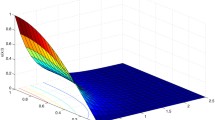Abstract
We propose an iterative solution method for an implicit finite-difference analog of the inverse problem of identifying the diffusion coefficient in an initial boundary value problem for the subdiffusion equation with the fractional Caputo time derivative. We consider the two different ways of setting the overdetermination condition at the final time point: the value of the solution at some given point and a weighted integral of the solution. The results of numerical implementation of the iterative method are presented on model problems with exact solutions. These results confirm the sufficiently high accuracy of the method.






Similar content being viewed by others
REFERENCES
I. Podlubny, Fractional Differential Equations (Acad. Press, San Diego, 1999) [Ser. Mathematics in Science and Engineering].
A. I. Prilepko, D. G. Orlovsky, and I. A. Vasin, Methods for Solving Inverse Problems in Mathematical Physics (Marcel Dekker, New York, 2000).
A. M. Nakhushev, Elements of Fractional Calculus and Their Application (Kabardino-Balkar Sci. Center, Nalchik, 2000; Fizmatgiz, Moscow, 2003) [in Russian].
A. Kilbas, H. M. Srivastava, and J. J. Trujillo, Theory and Applications of Fractional Differential Equations (Elsevier, Amsterdam, 2006).
K. Diethelm, The Analysis of Fractional Differential Equations (Springer, Berlin, 2010).
M. Caputo, “Linear Model of Dissipation Whose Q Is Almost Frequency Independent. Part II,” Geophys. J. Astronom. Soc. 13, 529–539 (1967).
O. P. Agrawal, “Solution for a Fractional Diffusion-Wave Equation Defined in a Bounded Domain,” Nonlinear Dynamics 29, 145–155 (2002).
P. Zhuang and F. Liu, “Implicit Difference Approximation for the Time Fractional Diffusion Equation,” J. Appl. Math. Comput. 22 (3), 87–99 (2006).
Y. Lin and C. Xu, “Finite Difference/Spectral Approximations for the Time-Fractional Diffusion Equation,” J. Comput. Phys. 225, 1533–1552 (2007).
D. A. Murio, “Time Fractional IHCP with Caputo Fractional Derivatives,” Comput. Math. Appl. 56, 2371–2381 (2008).
A. A. Alikhanov, “A New Difference Scheme for the Time Fractional Diffusion Equation,” J. Comput. Phys. 280, 424–438 (2015).
A. A. Alikhanov, “Stability and Convergence of Difference Schemes for the Boundary Value Problems of Fractional Diffusion Equations,” Zh. Vychisl. Mat. Mat. Fiz. 56 (4), 572–586 (2016) [Comput. Math. Math. Phys. 56 (4), 561–575 (2016)].
A. K. Bazzaev and I. D. Tsopanov, “Difference Schemes for Partial Differential Equations of Fractional Order,” Ufim. Mat. Zh. 11 (2), 19–35 (2019).
V. M. Goloviznin and I. A. Korotkin, “Methods for Numerical Solution of Some One-Dimensional Equations with Fractional Derivatives,” Differentsial’nye Uravneniya 42 (7), 907–913 (2006) [Differential Equations 42, 967–973 (2006)].
M. Zecova and J. Terpak, “Heat Conduction Modeling by Using Fractional-Order Derivatives,” Appl. Math. Comput. 257, 365–373 (2015).
A. N. Tikhonov, A. V. Goncharsky, V. V. Stepanov, and A. G. Yagola, Numerical Methods for the Solution of Ill-Posed Problems (Springer, Netherlands, 1995).
A. A. Samarskii and P. N. Vabishchevich, Numerical Methods for Solving Inverse Problems of Mathematical Physics (Walter de Gruyter, Berlin, 2008) [Ser. Inverse and Ill-Posed Problems, Vol. 52].
S. I. Kabanikhin, Inverse and Ill-posed Problems: Theory and Applications (Walter de Gruyter, Berlin, 2011) [Ser. Inverse and Ill-Posed Problems, Vol. 55].
J. Janno, “Determination of the Order of Fractional Derivative and a Kernel in an Inverse Problem for a Generalized Time Fractional Diffusion Equation,” Electron. J. Differ. Equat. 199, 1–28 (2016).
M. D’Ovidio, P. Loreti, A. Momenzadeh, and S. Ahrabi, “Determination of Order in Linear Fractional Differential Equations,” J. Fract. Calculus Appl. Anal. 21 (4), 937–948 (2018).
Z. Li and M. Yamamoto, “Uniqueness for Inverse Problems of Determining Orders of Multi-Term Time-Fractional Derivatives of Diffusion Equation,” Appl. Anal. 94, 570–579 (2015).
A. N. Bondarenko and D. S. Ivaschenko, “Methods for the Numerical Solution of Boundary Value Problems in Theory of Anomalous Diffusion,” Sibir. Electron. Mat. Izv. 5, 581–594 (2008).
G. Li, D. Zhang, X. Jia, and M. Yamamoto, “Simultaneous Inversion for the Space-Dependent Diffusion Coefficient and the Fractional Order in the Time-Fractional Diffusion Equation,” Inverse Probl. 29, 065014 (2013).
L. Sun, X. Yan, and T. Wei, “Identification of Time-Dependent Convection Coefficient in a Time-Fractional Diffusion Equation,” J. Comput. Appl. Math. 346, 505–517 (2019).
A. Kardashevsky, “Fractional Derivative Order with Respect to Time for a Diffusion Equation: An Iterative Method of Determination,” J. Phys.: Conf. Series 1715, 012035 (2021).
V. I. Vasiliev and A. M. Kardashevsky, “Numerical Identification of Order of the Fractional Time Derivative in a Subdiffusion Model,” Mat. Zametki Sev.-Vost. Fed. Univ. 27 (4), 60–69 (2020).
A. I. Kozhanov, “The Heat Transfer Equation with an Unknown Heat Capacity Coefficient,” Sibir. Zh. Ind. Mat. 23 (1), 93–106 (2020) [J. Appl. Ind. Math. 14 (1), 104–114 (2020)].
Funding
The authors were supported by the Ministry of Education and Science of the Russian Federation (supplementary agreement no. 075–02-=2020–1543/1).
Author information
Authors and Affiliations
Corresponding authors
Additional information
Translated by L.B. Vertgeim
Rights and permissions
About this article
Cite this article
Vasil’ev, V.I., Kardashevsky, A.M. Iterative Identification of the Diffusion Coefficient in an Initial Boundary Value Problem for the Subdiffusion Equation. J. Appl. Ind. Math. 15, 343–354 (2021). https://doi.org/10.1134/S1990478921020162
Received:
Revised:
Accepted:
Published:
Issue Date:
DOI: https://doi.org/10.1134/S1990478921020162



